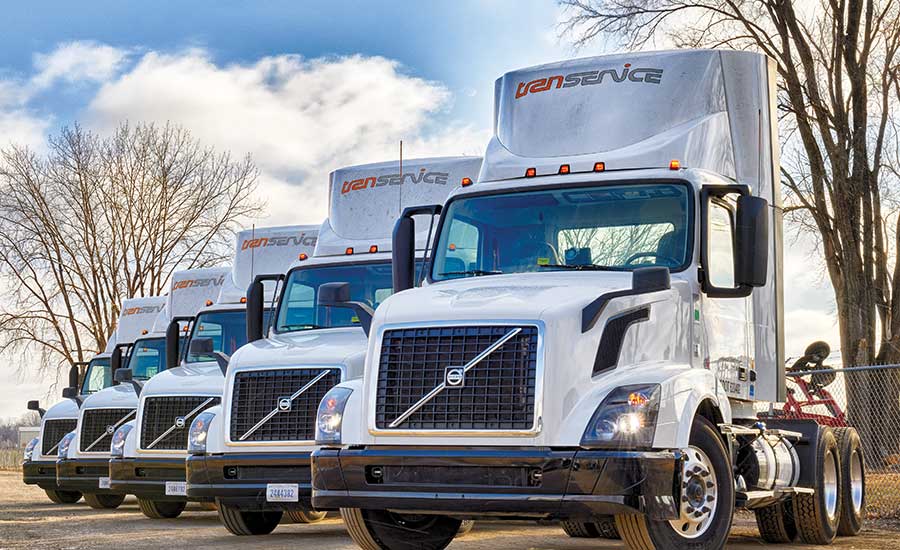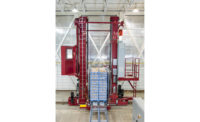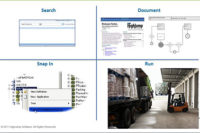The supply chain and logistics space has always been a male-dominated industry.
However, it’s entering a major phase of disruption, driven by ever-increasing consumer demands and increased speed in technology. To succeed in this business, companies need to diversify their group of talent, and in doing so, onboard more women.
“Women are proven to be great leaders during disruptive change, due to their collaborative nature and willingness to listen and engage,” says Kendra Phillips, chief technology officer and vice president of new products for Ryder System, Inc., Miami, Fla. “This type of leadership will be essential for the future of the supply chain and logistics industry.”
In fact, a survey released by Gartner, Stamford, Conn., and conducted in partnership with Achieving Women’s Excellence in Supply Chain Operations, Management and Education, Chicago, shows sustained strong representation of women in the senior-most ranks of supply chain organizations relative to other functions.
In addition, more respondents reported supply chain-led goals and initiatives to improve gender diversity compared with 2017.
Likewise, increasing the visibility of successful women leaders as role models is one of the most important things companies can do to impact recruitment and retention as well as advancement of women to senior levels, the study says.
That’s because the insurgence of women in the supply chain field is the industry’s recognition of diversity and inclusion, says Debbie Hodges, vice president of supply chain for health and wellness/print solutions, Puerto Rico for Walmart, Bentonville, Ark.
“The rise in women in supply chain will translate to businesses having a broader foundation to help create end-to-end solutions and innovations,” Hodges adds. “High-performance teams that deliver top-notch results will need to have top talent who bring a broad perspective to the decision table. Diversity and inclusion in the supply chain and logistics industry will help strengthen those decision that are made in business meetings and board rooms. Ultimately, the rise in women in supply chain will contribute positively to the bottom line of the business.”

DHL Global Forwarding developed Women in Management, an initiative designed specifically for women that offers specialized training and flexible working conditions, among other benefits.
What’s more is that at one point, the supply chain and logistics industry was looked at as just truck drivers and trucks, adds Lia McCarthy, national logistics design analyst for Transervice Logistics, Lake Success, N.Y. Today though, its about fresh ideas, challenging the norm and setting new standards.
“[The influx of women] has become more of an opportunity to problem solve, plan in advance, optimize and think outside the box,” says McCarthy.
Case in point, a research paper published by Stay Metrics, South Bend, Ind., found that female drivers tend to be more satisfied in most areas with their carriers, feel less bored by their work and feel more fairly compensated and satisfied with their home/work balance. Female drivers also scored significantly higher in pre-turnover thoughts, which indicates they are less likely to leave their present carriers than male drivers.
“In short, they are more loyal when treated well. Their top turnover predictor is their equipment, which correlates to safety. Give them good treatment, stable earnings and safe equipment and they are likely to stay at higher levels. They are generally safer drivers taking fewer risks and handle procedure and paperwork better,” says Jerry Scott, chief operating officer for Stay Metrics. “I honestly think that in the 25 years that it will take for autonomous vehicles to make a material difference in capacity, women could be the savior of trucking and everything that would mean for supply chain and logistics in general.”
Programs push women up the logistics ladder
In 2017, Women In Trucking Association, Inc. (WIT), Plover, Wis., announced a new program that serves as a platform to assist in establishing 150 new women-owned small businesses within the transportation sector over the next 12 months. Developed as part of a strategic partnership with Expediter Services, Memphis, Tenn., the program offers accessible financing as well as operational and business support for women interested in entering the trucking industry.
“Women aren’t confining themselves to traditional roles. Nearly every large carrier was started by one man and a truck, but now we’re seeing more women taking over their father’s businesses, and being very successful at it,” says Ellen Voie, president and CEO of WIT.
For its part, Deutsche Post DHL Group developed Women in Management, an initiative designed specifically for women that offers specialized training and flexible working conditions, among other benefits.
“Pushing for more diversity and gender equality to engage women in logistics not only benefits women in general, but [also] all employees because it brings new perspectives to the table,” says Renata Mihich, country manager, DHL Global Forwarding, Canada, part of Deutsche Post DHL Group. “The proportion of women sitting on supervisory boards has moved from 30% to 40% in the past five years, which is quite the accomplishment. There is still a lot of work to do, but I think we are on the right path.”
Walmart created a new diversity selection initiative that focuses on the hiring, growing and promoting of top female talent and talent of color.
“I also give a lot of credit to colleges and universities that have developed robust curriculum in STEM (science, technology, engineering and math) majors that attract more women in previously male-dominated roles such as supply chain and transportation,” says Hodges.

The supply chain industry is entering a major phase of disruption, driven by ever-increasing consumer demands and increased speed in technology, according to Ryder System.
The industry is also starting to see more women in the C-suite of transportation and logistics companies because they’ve worked their way up the ladder.
“You are going to see change not only in the culture of transportation and supply chain, but also in how the business is managed and run,” says Kari Beeson, senior director of recruitment and retention for Transervice Logistics. “As more women move into the C-suite or executive level, you will see a different take from a creativity, innovation and productivity standpoint.”
Leading the next generation of women
As more women become more visible in the supply chain industry, it encourages the next generation to consider this to be an ideal career opportunity, according to Voie.
“When there are women in leadership in any organization, it has been shown to increase the company’s profits,” she adds. “And, today’s women are more confident in male-dominated professionals. The lines are blurring in regard to men’s and women’s occupations. Nothing is off limits anymore.”
College student data reveals the potential driver of increased gender diversity in logistics and supply chain management is the increase in women college professors in the field, according to Dr. Hannah Stolze, associate professor of marketing and supply chain management, Department of Economics, Wheaton College, Wheaton, Ill.
“One of the questions in our college student survey asked students (both young men and women) what they attribute their successes to thus far. When compared to young men, the young women in the sample were much more impacted and inspired by their professors,” Stolze says. “Thus, it is likely that the growth we’ve seen in gender diversity of college professors teaching logistics and supply chain management has driven an increase in young women who view the career path as a viable and attractive option. We have seen a significant increase in the number of internships being made available to students. Some universities even require internships in order to get a logistics and supply chain management degree. With the increase of young women in the major, by default, we’re also seeing more ‘experienced’ young women entering the career.”
And, because supply chain and logistics is a broad field, it will forever be in demand. That’s why it’s imperative that the industry begin working with local schools and universities to expose young kids, especially young girls, to STEM.
“It would be cool to see some industry leaders and companies begin to expose elementary and high school-age girls to our industry,” says Scott. “As more women become drivers, as more women achieve middle management and as more women achieve senior levels, mentoring and role modeling will only serve to accelerate the progress.”
Breaking down barriers
A study conducted by Ohio State University, Columbus, Ohio, asked respondents (both men and women) whether they experienced differential treatment in the workplace due to gender or ethnicity. About a fourth of the participants felt they’d been treated differently, with 70% of that sub-sample being women. This implies that despite the disruption of women in the industry, gender-related career roadblocks still exist.
That’s why one of the keys to success is mentorship.
“Young women should actively seek out mentors, and the earlier in their career, the better,” says Dr. Terry Esper, associate professor of logistics for the Department of Marketing & Logistics for Ohio State University’s Fisher College of Business. “One of the major concerns that we’ve heard through the annual study of women in the professional ranks is that they’ve often struggled with keeping up with the changing trends in the field. Hence, young women should enter the career with a resolve to stay abreast of the ‘latest and greatest’ through continuous learning and professional organization affiliations.”
Additionally, the supply chain and logistics industry as a whole needs to share women’s success stories, both internally and externally, says Mihich.

The supply chain and logistics industry used to be viewed as just truck drivers and trucks, according to Transervice Logistics. Now, there’s so much more to it.
“Representation is powerful because it inspires hope for a future,” she adds. “The logistics industry has many opportunities that anyone can advance in regardless of gender. Believe in yourself, and don’t be afraid to highlight yours and your team’s successes. Stay visible for that next promotion.”
And, more women are in position to step up and lead due to their ability to multi-task, adds Hodges.
“Women are effective at choreographing projects and teams that are made up of numerous workstreams and face multifaceted challenges,” she says. “In addition, women are also showing up and bringing their whole selves to work. Choose a sponsor who will teach you the business, caringly critique your performance and passionately advocate for you when the promotion opportunities surface.”
On the other hand, maybe there aren’t roadblocks for women to overcome. That’s why women need to expand their horizons and look at the transportation industry as a whole for opportunities.
“Many of the roadblocks are the result of our own self-doubt and hesitancy. We need to ask for recognition, push for raises and advancement and speak up at meetings. I’ve found that men are very accepting when women are capable,” says Voie.
Also, it’s advised to not be intimidated by the women-to-men ratio.
“If you like to solve problems, analyze cost and interpret data in a dynamic environment, then this industry can provide that and so much more,” says McCarthy. “You will interact with a lot of different departments (sales, operations, finance, accounting and human resources, to name a few). All these departments touch supply chain and logistics. There are so many opportunities that can stem from that initial career choice.”
The recent infiltration of women continues to disrupt the culture of the marketplace, translating to diversity, inclusion and a different way of doing business.









